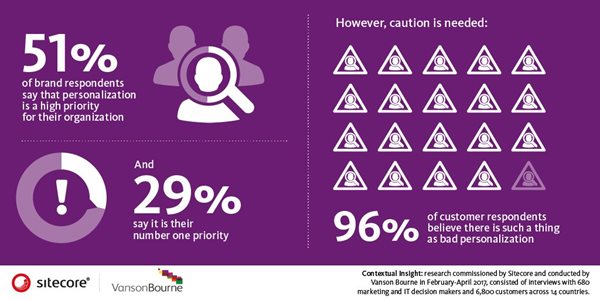Sitecore Execs on Personalization and Sitecore Experience Cloud
By Venus Tamturk
October 30, 2017
big data, commerce, content marketing, Exclusive Interviews, omnichannel, Personal Data, personalization, sitecore, Sitecore Symposium, Web Content Management
In the middle of last week, we published a roundup of my takeaways from this year’s Sitecore Symposium to give our readers a sneak peek into the conversations we seized directly from the event floor. As I mentioned in my recap, we were fortunate enough to capture all of the different, invaluable perspectives from the Sitecore family. So today, it’s time to begin sharing some of that wisdom with all of you! This article includes the exclusive video interviews with Sitecore’s two seasoned executives, Joe Henriques and Ryan Donovan that we filmed at the event as well as my brief commentary on their talking points.
Joe Henriques Sheds Light on Impediments To Personalization
Aside from utilizing Sitecore as their digital experience platform, another thing that every interviewee had in common was the fact that they all were tasked with delivering personalized experiences. That being said, a recent research commissioned by Sitecore and conducted by Vanson Bourne found that 96% of 6800 customer respondents believe many brands are in fact, providing “bad personalization,” which upon deeper analysis, is no personalization at all. When we turn the spotlight on to the other side of the table to understand what type of impediments are causing this dissatisfaction, the study illustrates that while 80% of 680 marketing and IT decision makers place a high priority on personalization, they struggle to manage and mine customer data to both inform customer experience strategies and deliver on the promise of personalization. To go in-depth on these interesting findings and more, I sat down with Joe Henriques, Vice President of Innovation at Sitecore during Sitecore Symposium 2017 in Vegas:
Customers Don’t Share Data about Themselves
First and foremost, I was curious to hear what stuck out most to Henriques among the findings revealed. During our conversation, he expanded on two interesting points in particular: “Among the findings, there are two things that really jumped out at me. One was that 54% brands are making assumptions about what customers want based on single interactions as I assumed that by this point of time we have gone past that. The other that jumped out of me is that 60% of organizations are having difficulty with personalization as their customers don’t share data about themselves,” said Henrique.
In today’s consumer world, I personally feel like using state-of-the-art analytical technologies is a prerequisite for thriving in customer experience. Being armed with predictive insights helps organizations uncover hidden opportunities and competitive threats - turning negative customer feedback into promotions, eliminating biased decision-making processes as they take the guesswork out of customer relationship, and gain a broader view of their positioning against the competitors to name a few. Having said that, without enough data, none of those could be accomplished. On that note, Henriques made a great point by saying: “If you want to collect data about someone, you have to give them something in return,” and apparently, “many organizations haven’t figured that out yet.” He suggested they create a two-way street relationship with their audience.
I definitely agree! Furthermore, in my opinion, to tackle this issue, marketers also should focus on both explicit and implicit insights. While explicit insights can be gathered through consumers’ transactions, responses to campaigns, orders, and returns, implicit signals can be attained from time spent on specific product pages, offers hovered over for a certain period of time, previously visited sites, customers’ feelings shared on social media, and what information is shared on online forums. Combining both of these is the secret sauce to fully understanding the pattern that can ultimately allow them to interact more effectively with the right audience at the right time across the right channels. That way, unlike 54% of decision-makers surveyed who are making assumptions based on single interactions, organizations can acquire and nurture consumers based on all the activities through the sales funnel, from initial browsing to final conversion. Here are other key findings from the survey:

Real-World Examples: Chick-fil-A & Atlantis The Palm
After covering all bases from a theory of personalization standpoint, I wanted to pick Henriques’ brain on the practical perspective, given he consistently interacts with Sitecore customers and partners. To that point, I asked him why he thinks it has taken so long for merchandisers and marketers to deliver a consistent and personalized experience across channels. There are two impediments that are holding marketers and merchandisers back, according to him. The first one is “silo-ness of data” as he sees it as a roadblock to “creating the single view of a customer.” The second hindrance is executives who are not taking part in the discussion and brainstorming a solution. At the end of the day, Henriques indicates that as a business partner, Sitecore can help with these issues, to a certain extent, but to tackle the problem at its roots, organizations that struggle with those, need to make significant changes to their company structures and cultures.
Considering all the great suggestions he gave us during our conversation, I was eager to hear  his favorite brand(s) that he feels, are excelling with their personalization and omnichannel strategy. The first example was popular fast food chain Chick-fil-A which happens to be one of Sitecore’s customers as their strategic use of analytics and personalization has led to increased engagement with editorial content, improved conversion on key campaigns, increased app downloads and purchases, and higher online catering revenue. Henriques characterizes Chick-fil-A’s personalization as “utilizing a digital body language.” He is impressed by how they initiate continuous interactions across channels and devices.
his favorite brand(s) that he feels, are excelling with their personalization and omnichannel strategy. The first example was popular fast food chain Chick-fil-A which happens to be one of Sitecore’s customers as their strategic use of analytics and personalization has led to increased engagement with editorial content, improved conversion on key campaigns, increased app downloads and purchases, and higher online catering revenue. Henriques characterizes Chick-fil-A’s personalization as “utilizing a digital body language.” He is impressed by how they initiate continuous interactions across channels and devices.
 The second one was Atlantis The Palm, Dubai, a resort with more than 1,500 rooms, 20+ restaurants, marine and waterpark interactions. Henriques is very amazed by their omnichannel strategy. He gave an example: “They know that you have looked at their spa online so they let you know that there is a spa appointment available at 12 o’clock.”
The second one was Atlantis The Palm, Dubai, a resort with more than 1,500 rooms, 20+ restaurants, marine and waterpark interactions. Henriques is very amazed by their omnichannel strategy. He gave an example: “They know that you have looked at their spa online so they let you know that there is a spa appointment available at 12 o’clock.”
Lastly, he suggested those who are striving to thrive in delivering personalized experiences embrace the crawl-walk-run approach instead of trying to hit a home run right off the bat.
Sitecore Experience Cloud In Depth with Ryan Donovan
To discuss the new announcements and the roadmap of the platform in depth from a product standpoint, I also caught up with Ryan Donovan, Executive Vice President of Product Management at Sitecore, during Sitecore Symposium 2017.
First things first, I wanted to inquire about what Sitecore wants to achieve with Version 9 and how Donovan would characterize this new release. “With Sitecore 9, what we are really looking for is to empower our customers to create a single omnichannel view of their customers,” said Donovan and elaborated how exactly this would work: “With the new xConnect feature in Sitecore 9, we want to allow our customers to be able to pull in every customer experience from any channel - it’s whether their CRM system or ERP system or point-of-sale system, you name it because from there, they can create a single view of the customer and then personalize against that.” As an example of connecting all data across a digital ecosystem, he explained how pointless it would be to sell an iPad accessory to a person who has recently bought an iPad online but returned it to the physical store later to buy a Surface book.
What Has Changed Through Version 7 – 8 – 9
As you may recall, version 7 had been focused more on the technical features that mostly  benefited IT users, whereas version 8 was all about empowering business users through an intuitive user interface. To me, the focus of version 9 seems to be on the data-driven contextual marketing side of the things. However, I was eager to hear Donovan’s thoughts on that. He said that the focus with Version 7 was on performance and scalability and that decision was driven by the demand from Sitecore’s large accounts for being able to manage their sheer volume of content. He also certainly agreed with my observation on the focus of Version 8. With this progress in mind, he characterized Version 9 as “the transition point from the web channel to the omnichannel.”
benefited IT users, whereas version 8 was all about empowering business users through an intuitive user interface. To me, the focus of version 9 seems to be on the data-driven contextual marketing side of the things. However, I was eager to hear Donovan’s thoughts on that. He said that the focus with Version 7 was on performance and scalability and that decision was driven by the demand from Sitecore’s large accounts for being able to manage their sheer volume of content. He also certainly agreed with my observation on the focus of Version 8. With this progress in mind, he characterized Version 9 as “the transition point from the web channel to the omnichannel.”
When it comes to the drive behind this direction, he said: “Our customer wanted to create a holistic view of their customers that reflects every interaction – not just what’s happening on the web. Therefore, with Version 9, we have given them a platform to do that and personalize it.” In other words, with the new features rolled out, marketers will have a handle on intelligent insights to help them deliver highly personalized omnichannel experiences.
Additionally, he indicated that with Version 9, they built next-generation user experiences based on a lot of lessons learned from the digital marketers who have worked with Version 8. What is involved in the next-generation user experiences are the next-generation forms experiences as well as the next-generation automation experiences, and they are reflected upon years of usability research and a fresh approach to address the usability needs of digital marketers, according to Donovan.
Digital Maturity is the Key to True Personalization
Since the topic of personalization has come up quite a bit during our conversation, I asked why he thinks it has taken so long for merchandisers and marketers to deliver a consistent and personalized experience across channels. Donovan believes that the underlying issue is the level of brands’ digital maturity: “A lot of brands need a help to achieve a certain level of personalization where they can really benefit from personalization.” In recognition of this need, Sitecore has engaged with their clients to help them improve their digital maturity, and as a result, their clients had amazing success stories, according to Donovan. I liked that the vendor didn’t only provide the capabilities through their platform but also they mentored their clients on their path to personalization. It demonstrates that Sitecore goes beyond a technology provider-buyer relationship to a business partnership with its customers.
Donovan also adds that improving digital maturity and reaching the point where organizations can truly leverage the benefits of personalization requires reimagining every step of their journey which affects many business cases in all departments of organizations. I couldn’t agree more with him on this note because to me, without setting up a clear alignment on the goals, execution, deployment, and strategy, a claim on delivering personalized experiences “across all channels” remains, unfortunately, vague or, far worse, it results in “bad personalization.”
A Christmas Gift from Sitecore
Lastly, I wanted to inquire whether he has an Easter egg from Sitecore that we will see in the near future but even better, he gave me a Christmas present, saying that the release of Sitecore Commerce 9 is expected to be announced around Christmas time this year. Hooray! All we want for Christmas is Sitecore Commerce 9. Well, not really but I will share my list in another article.
How he characterizes this upcoming release is “an initial completion of Sitecore’s vision of how a modern commerce platform should be.” Sitecore Commerce 9 will also mark the world’s first ASP .Net Core based modern and microservices commerce platform, Donovan claimed. Since it has absolutely no legacy technology in it and no ties to Commerce Server whatsoever, the new version will provide extreme flexibility and extensibility.
I will be diving deeper into this when the new release comes out but for those who are not familiar with what it means to be shifting away from Commerce Server, customers will no longer need the Commerce Server install and all the Commerce Server code. The installation of the new commerce engine has been simplified, meaning customers will be able to utilize Commerce 9 on Azure PAAS and also possibly to run Commerce 9 in a Docker container. This change will ease the pain, especially for people who are not very familiar with both Commerce Server and Sitecore Commerce.
MY POV
Personalization is always of great interest to me. Apparently, I am not one of a kind as during Sitecore Symposium, no matter if the person I spoke with was a customer or a technology partner; everyone couldn’t stress enough the importance of personalization.
Businesses need to know which steps happen online, which steps happen offline, whether the entire journey is completed through only one digital channel, say, their website, or are visitors bouncing across different channels. Not only that but also how these visitors react to the brand’s interactions, for how long they spend exploring their content, offerings, and so on. These all make the trail of breadcrumbs left by us consumers, whenever we interact with a brand so that data is crucial.
My understanding from all the great points Henriques made is that organizations need to underpin the creation of new business models by integrating ecosystems of people, business, and things to excel with their personalization and omnichannel strategies. Additionally, I really liked the phrase he used for Chick-fil-A “utilizing a digital body language.” Knowing the fast food chain wants to bring more of a connection fans feel with Chick-fil-A restaurants online, it couldn’t be described any better.
However, to make all of these work requires a certain level of digital maturity, as Donovan pointed out and I guess that’s where your technology provider comes into play. With the insider scoop on the new version and the future direction we got from Ryan Donovan, Sitecore seems to reduce a lot of implementation complexities, and increase time to value for their customers while providing a handle on intelligent insights to help them deliver highly personalized omnichannel experiences.
In the upcoming days, we will continue to share the wisdom from the other side of the table as we also interviewed many customers and their Sitecore solution partners at the event. So stay tuned!
Related Sitecore News:

Venus Tamturk
Venus is the Media Reporter for CMS-Connected, with one of her tasks to write thorough articles by creating the most up-to-date and engaging content using B2B digital marketing. She enjoys increasing brand equity and conversion through the strategic use of social media channels and integrated media marketing plans.